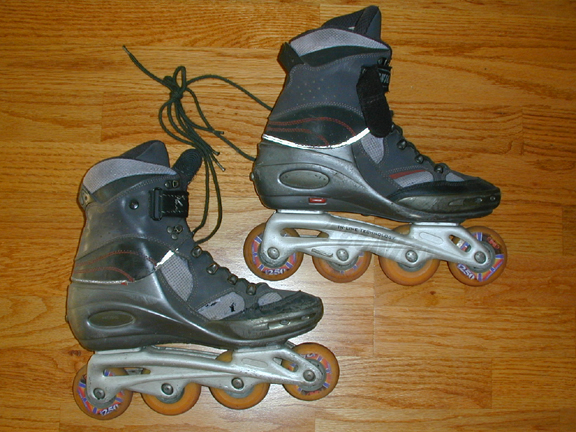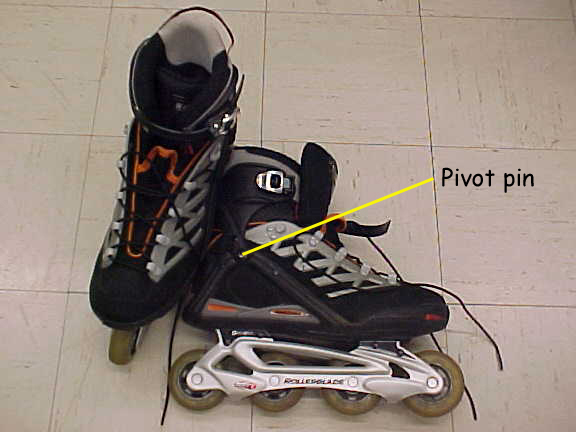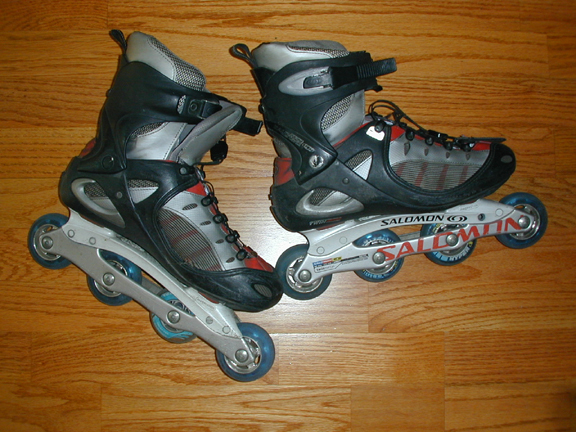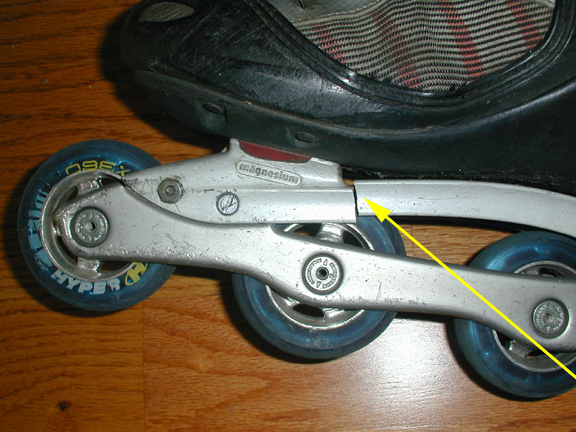

| |
SKATES
Let's talk skates. We're talking in-line skates. The major components are the boot and the bearings and the wheels. To me the most important thing is the boot. If you skate often the wheels and bearings will be replaced on a regular basis so you are always in a position to try new ones but the boot had better fit well.
Boot Specifics
I will only talk about the boots I have owned and used.
My first good pair of skates were Macroblades made by Rollerblade. I think if they were still manufactured I would buy them. The boot was all plastic with three adjustable straps. The ankle part of the boot did not swivel about a pin joint like almost all other boots do. Rather it flexed. The runner for the wheels was all plastic but it was so strong and light. I am an engineer and can tell you first hand; whoever designed this wheel mount was good. I personally don't like plastic for the wheel runner but, as opposed to my Soloman skates that I have now, that are made out of a two part aluminum/magnesium frame riveted together, the plastic held up much better. But then again a lot has to do with the design and not simply the use of plastic. The three adjustable straps allowed for quick turnover time when putting them on and the strap that went around the ankle provided you good support.

My second good pair of skates was made by Tecnica. On the tongue of the boot it says TOMCAT. This boot was pure lace up and not made out of plastic but rather some sort of material with a few strips of plastic for support. Around the ankle went a support strap that Velcroed closed. Here again there was no pin joint at the ankle for swiveling. The advantage of laces is that the boot is allowed to make small but sometimes very important compliances to your foot. Of course, they take longer to lace up than the adjustable straps and I found that I started to get serious callouses from where the laces would rub


My fourth pair is the Solomons. This boot is made of some sort of material along with a modest amount of plastic. It does have the pin pivot and also has straps and laces. This is a good compromise because you get the conformity from laces with the ankle support of the strap. They also came up with a clever way to pull the laces tight which involves pulling down on a small plastic locking device (similar to what you might find on a backpack). You never have to tie them. It works well and doesn't give you callouses. The only problem is the skates have fallen apart. The wheel runners are made of two materials; aluminum

and magnesium. The two parts are riveted together. I hate rivets especially the hollow type. These rivets have almost all come out and have been replaced with screws and nuts. But the final blow came when the magnesium piece developed a crack that has grown and eventually caused a failure clear through the entire piece. Admittedly they are a couple of years old now but my other skates lasted longer.
CHECK OUT THAT CRACK!
Laces or straps: It's a hard choice. Go with what feels good. I do not recommend Velcro.
Pivot Pin: I keep mentioning the pin pivot at the ankle. I don't like it a bit. At first you might think that the ankle joint does pivot basically like a pin joint but it does not. Your ankle does pivot up and down but it also swivels left and right. You might think that this motion is far less important than the up and down pivot action but it is in fact a very important degree of freedom that your ankle and most other joints in your body possess. It is also this multi-degree of freedom motion that has led to the latest generation of prosthetic joint replacements and artificial limbs. I find that boots with the pivot pin don't flex as much as they should in the left to right direction. The only problem is that the vast majority of skate boots incorporate the pivot pin. Too bad. The exception being hockey skates such as the ones made by Mission.
Wheel Frame Adjustability: Another important feature is whether or not you can adjust the wheel frame left or right along the boot. Sometimes I put on a pair of skates and the wheels don't feel like they're under the center part of my feet. They feel too much on the outside of my foot. My favorite skates allow you to adjust the entire wheel frame a little left or right. A small adjustment means a lot because your foot is relatively narrow so several skate manufactures do allow about 1/4 inch of adjustment in the wheel frame.
Wheel Base: Yet another consideration is the length of the wheel base. Racing skates have very long runners that usually accomodate five wheels instead of the standard four. But even four wheel skates vary quite a lot in the length of the wheel base. When the wheels extend beyond the boot crossing over and performing other tricks becomes more difficult. Several of the best skaters I know use hockey skates for freestyle skating primarily because of the shorter wheel base. The Solomon skates, in my opinion, have too long a wheel base. Plenty of skates today have 110 mm wheels. These skates are probably great for going long distances but they are just too big for me. Your too high off the ground and the wheel base is way to long for me. My present skates have 84 mm wheels and this is the max I'm comfortable with.
Rockering the Wheels: Another consideration is whether or not you can rocker the wheels. That means the two middle wheels are placed a little lower than the front and back ones. This makes the skate look a bit like a rocking chair. It allows you to swivel on your skates easier. Many good skaters swear by it. I have never tried it. A lot of skates do not even allow you this option so if you think you may want it consider this when you buy. It's probably something to think about once you've gotten to a certain level of skating. Ocasionally a salesman will tell you that if you want to rocker "unrockable" skates you can always buy larger diameter wheels and place them in the two center positions. Although this may work it's not the way it should be done.
New Trends: Yet another new advance is a boot that can be heated up and while still hot you sink your foot into it. As the boot cools down it becomes customized to your foot. I believe the boot is placed in an oven or heated up with a hot gun. Of course, you have to buy the skates before the store will customize it to your foot. I have never owned such a skate but the idea intrigues me. I sort of have my doubts that the customizing holds up. It gets mighty hot inside a skate boot when your skating and most plastics tend to get droopy well before you reach their melting point.
There are also many new trends involving tightening up the laces on boots
that have laces. I remember there was a Rollerblade that had, mounted in
the back of the skate, a device that with one pull of a tab you tighten
the laces. It didn't look like a good idea to me. I feel that anything
that makes the skate bigger and bulkier is generally bad.
Bearings
Now let's talk bearings. An engineering student at Columbia University, where I work, came up to me one day and took his rollerskates and gave the wheel a flick with his finger. The wheel spun really fast and kept spinning for a long time before it finally came to rest. He looked at me and said "Awesome bearings, almost no friction." I felt the wheel with my fingers and could feel a lot of slop in the bearings. I told him that the bearings were bad. He looked incredulous. When I showed him my wheels he gave them a similar finger flick. They spun for a while but not nearly as long as his did. I told him that my bearings where almost new. It's not all about friction. I could insert a small wooden dowel inside a skate wheel and give it a flick. It would spin for a long time even though the bearings wouldn't even be rotating. It's more about smoothness, and how the bearing functions under load. A good bearing feels silky smooth when you rotate it and a lot has to do with how it performs when spining slowly not fast.
ABEC1, ABEC 3, ABEC 5, ABEC 7...what does this all mean? ABEC stands for Annular (not annual) Bearing Engineering Committee. Annular as in an annulus or ring. The bearings consist of an outer race, and inner race, sometimes a cage (that holds the balls), the ball bearings, and sometimes a shield (see Equipment Maintenance). Without going to deep into it the ABEC standards involve a metrologist dream come true. Metrologist, not to be confused with meteorologist or weather men, are people who make very precise measurements and set standards and tolerances for parts. So for example the balls themselves are supposed to be perfectly spherical. We've all tried to make the perfectly spherical snowball or meatball and you know it's not easy to make and not particularly easy to measure. If the balls have a small imperfection in them (a little flat part) then as they rotate inside the bearing there will come a time when that little flat part has to roll around the races. This is when the problems start. Since these bearings rotate a lot it doesn't take long for that ball to become completely ruined. When this happens the bearing is shot. So the higher the ABEC rating the higher the tolerances are on all the parts and the longer the bearings will last, the smoother they will run, and everything about them is better. My first pair of skates had ABEC 1 bearings. They lasted a week. My next pair had ABEC 3 bearings and they lasted months maybe a year.When you evaluate bearings don't just flick them and see how long they spin for. Rotate them slowly and feel for any imperfections in the smoothness. If, as you rotate the bearing, you feel a spot where it catches a little or studders a bit, the bearing is probably starting to go bad or minimally needs a cleaning (see Equipment Maintenance).
Salesman will tell you that these bearings are so fast. But like I said it's not about the speed it's about the smoothness and your skill as a skater. If you want speed buy speed skates.
Wheels
Skate wheels now days are made of molded polyurethane. In my teenage
years skate wheels were made out of steel. The big breakthrough for us
kids was when the wheels went from hollow steel to solid steel. There
are two numbers associated with a polyurethane wheel. The first number
is the diameter of the wheel given in millimeters (mm). For example my
Solomon skates can take up to a 78 mm wheel. The second number is the
hardness given in a unit called durometer…the higher the number the
harder the polyurethane. For example 72 durometer is a soft wheel where
as 82 is pretty hard. I have a durometer meter at work. It is basically
a spring loaded pin that is attached to a needle that gets deflected when
you place the pin over the polyurethane. It measures how far the pin penetrates
into the surface and shows it as a number we call durometer. The wheels
don't feel much different to the touch but the feel of the wheels under
your body is very noticeably different. The durometer meter clearly shows
the difference between a 72 and an 82. . However you may have to get to
a certain level of skating before you feel this difference. Wheels can
also differ in profile shape. A wheel can be pretty flat on the bottom
like a cylinder or have a nice rounded profile. The parabolic profile
claims to have all sorts of nice qualities and they do. Unfortunately,
as you skate the wheels lose this rounded profile and it is a constant
task to rotate your wheels so that the profile does not get too slanted
in one direction.
What wheels to use? Ignoring all other factors I would use a soft wheel
with the biggest diameter my skates could handle and a parabolic profile.
The soft wheels feel so good under your feet and they allow you to hold
a good edge. The big drawback is that they are soft and they simply wear
too fast. The last time I bought 72 durometer wheels they lasted me two
weeks. So I usually by 82 durometer wheels. They're hard but they last
a lot longer. Since your wheels will start to get smaller the second you
start to skate I suggest starting off with the biggest diameter you can
put on the skates. Of course if you plan to grind and slide down staircase
banisters you're in a different world than I and I haven't clue what wheels
work best. I will say this, there's nothing sweeter than a new pair of
wheels. You know that commericial for the Lottery where someone tells
what they would do if they won the lottery? Well, I would hire someone
to put new wheels on my skates every day.
SAFETY EQUIPMENT
To become a really good skater you must accept the fact that you will fall down often (see how to fall). In fact, if you don't fall down somewhat regularly it probably means that you're not pushing your envelope enough. So wear safety equipment. I know that the best skaters often wear no safety gear at all.
I'm talking helmut, wrist guards, knee pads, and elbow pads. I will admit
that I wear only wrist guards. Why? Because I'm stupid. But let's face
it the more equipment you wear the less free you feel and skating is all
about feeling free. If I am practicing a very hard move I will put on
knee pads and a helmut. I can attest to the fact that on two ocassions
I fell and broke the plastic brace inside the wrist guard. Can you imagine
what would have happened to my wrist if I hadn't been wearing the wrist
guard? As far as wrist guards go I like the clam-shell style that velcroes
closed because it comes on and off easily and can accomodate gloves in
the cooler weather.